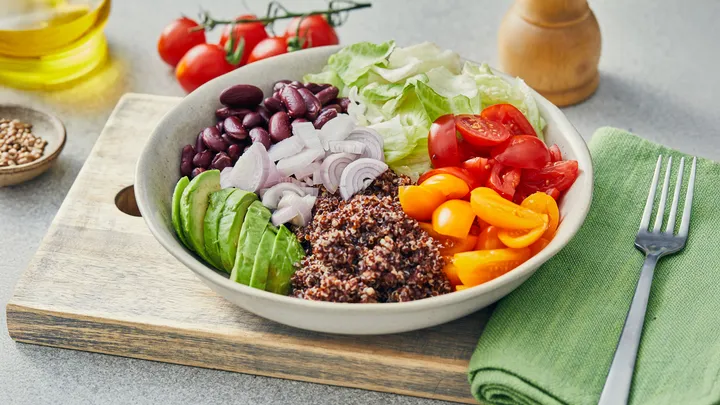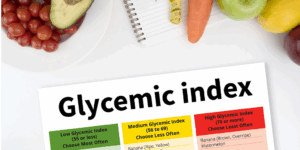Meal Planning Tips for People with Diabetes

Meal Planning Tips for People with Diabetes
Meal planning is an essential part of managing diabetes, as it helps to control blood sugar, maintain a healthy weight, and improve insulin sensitivity. A well-balanced diabetic meal plan can also reduce the risk of developing complications related to diabetes, such as heart disease, kidney damage, and nerve issues.
In this complete guide, we’ll provide you with a sample meal plan, along with tips and strategies for creating your own meal plan tailored to your needs. Whether you have Type 1, Type 2, or gestational diabetes, these meal planning tips will help you maintain optimal blood sugar control while enjoying a variety of healthy foods.
What is a Proper Meal Plan for a Diabetic?
A proper meal plan for a diabetic is designed to balance carbohydrates, proteins, and fats in a way that prevents blood sugar spikes and supports overall health. It is essential to focus on whole, nutrient-dense foods and avoid highly processed, sugary options. The goal is not just to regulate blood glucose levels, but to also maintain energy levels, prevent overeating, and avoid nutrient deficiencies.
Key Principles of a Diabetic Meal Plan:
- Portion Control: Keep portion sizes moderate to avoid overeating.
- Low Glycemic Index Foods: Choose foods that release sugar slowly into the bloodstream.
- Balance Carbs, Protein, and Fats: This helps manage insulin levels and improve satiety.
- High Fiber: Fiber helps control blood sugar and supports digestive health.
With these principles in mind, here’s a sample 1-day meal plan that incorporates balanced meals throughout the day.
Balanced Diabetic Meal Plan (Sample 1-Day)
Creating a balanced meal plan is key to managing diabetes. Below is a sample 1-day meal plan that includes foods that will keep your blood sugar levels in check while providing you with the necessary nutrients.
Breakfast:
- 1 bowl of oatmeal (unsweetened) with:
- 1 tbsp chia seeds
- A few almonds or walnuts
- ½ apple (sliced)
- 1 boiled egg or paneer cube
- Green tea or black coffee (no sugar)
Why this works: Oats are rich in fiber and help lower blood sugar levels. The healthy fats from nuts and protein from the egg/paneer balance your blood sugar.
Mid-Morning Snack:
- 1 small handful of roasted chana or nuts (10–12 pieces)
- 1 glass buttermilk or unsweetened almond milk
Why this works: This snack provides protein and fiber, which helps keep blood sugar stable until your next meal.
Lunch:
- 1 medium bowl of brown rice or 1-2 whole wheat rotis
- 1 bowl of dal or rajma/chickpeas
- Stir-fried or steamed greens (spinach, okra, beans)
- Cucumber + tomato salad with lemon juice
Why this works: Brown rice and whole wheat roti provide complex carbs, while dal and legumes offer protein and fiber, all of which work together to maintain steady blood sugar levels.
Evening Snack:
- 1 small fruit (like guava, kiwi, or a few berries)
- 1 tbsp peanut butter or 1 slice low-fat cheese
Why this works: A small fruit provides natural sweetness and fiber, while peanut butter or low-fat cheese provides protein and healthy fats to stabilize blood sugar.
Dinner:
- Grilled tofu/chicken/paneer with sautéed vegetables
- 1 small whole grain roti or ½ cup quinoa
- A bowl of clear soup (e.g., moong soup or vegetable broth)
Why this works: Grilled protein like tofu, chicken, or paneer helps control blood sugar, while vegetables provide essential vitamins and minerals. Quinoa is a whole grain and helps regulate blood sugar.
Bedtime (Optional):
- 1 tsp soaked fenugreek seeds
- Herbal tea or warm turmeric milk (no sugar)
Why this works: Fenugreek seeds are known for their blood sugar-lowering properties, and turmeric has anti-inflammatory effects that can help manage insulin resistance.

Key Meal Planning Principles for Diabetics
Effective meal planning for diabetes involves balancing macronutrients (carbs, proteins, and fats) and timing your meals. Here are some key principles to follow when planning meals:
1. Use the Diabetic Plate Method
This is a simple and effective method for portion control, ensuring that your meals are well-balanced.
Plate Portion Breakdown:
- ½ Plate: Non-starchy vegetables (e.g., spinach, cauliflower, kale)
- ¼ Plate: Protein (e.g., dal, paneer, tofu, chicken, fish)
- ¼ Plate: Complex carbs (e.g., quinoa, brown rice, whole wheat roti)
Why it works: This method helps you control portion sizes while ensuring that your plate contains fiber-rich vegetables, protein, and healthy carbs that promote stable blood sugar levels.
2. Focus on Low-Glycemic Foods
Choosing low-glycemic foods is crucial for blood sugar control. Low-GI foods release sugar into the bloodstream slowly, preventing sugar spikes.
Examples of Low-Glycemic Foods:
- Whole grains (e.g., quinoa, barley, oats)
- Beans and legumes (e.g., chickpeas, lentils)
- Vegetables with fiber (e.g., broccoli, kale)
- Whole fruits (e.g., berries, apples)
Why it works: Low-GI foods help maintain steady blood sugar and improve insulin sensitivity over time.
3. Include Protein + Healthy Fats at Every Meal
Including protein and healthy fats at each meal helps slow down the digestion of carbs and prevents rapid blood sugar spikes.
Examples of Protein and Healthy Fats:
- Lean proteins (e.g., chicken, tofu, paneer, eggs)
- Healthy fats (e.g., olive oil, avocado, nuts, seeds)
Why it works: Protein helps with satiety and blood sugar control, while healthy fats improve insulin sensitivity and reduce cravings.
Best Foods for Diabetics to Include
Here’s a list of diabetic-friendly foods to incorporate into your meal plan for better blood sugar control:
| Food Category | Best Choices | Why It Works |
|---|---|---|
| 1. Vegetables | – Leafy greens: Spinach, kale, collard greens- Non-starchy vegetables: Carrots, bell peppers, okra, zucchini- Cruciferous vegetables: Broccoli, cauliflower | Vegetables are high in fiber, low in carbs, and help regulate blood sugar. They also provide essential nutrients and antioxidants. |
| 2. Proteins | – Eggs, tofu, paneer, legumes (e.g., lentils, chickpeas)- Lean meats: Chicken, turkey, fish (especially salmon, sardines) | Protein helps regulate blood sugar and keeps you full for longer, preventing overeating and blood sugar spikes. |
| 3. Carbs (in moderation) | – Brown rice, quinoa, oats, barley- Whole grain breads, whole wheat roti | Complex carbs release sugar into the bloodstream more slowly, preventing rapid blood sugar spikes. |
| 4. Fruits (Low-Sugar) | – Berries: Strawberries, blueberries, raspberries- Guava, apple (with peel), kiwi- Papaya, oranges | These fruits are rich in fiber and vitamin C, and have a low glycemic index, making them excellent for blood sugar control. |
| 5. Fats | – Avocados, nuts, seeds, olive oil, coconut oil | Healthy fats improve insulin sensitivity and slow down the digestion of carbohydrates, preventing blood sugar spikes. |
Foods Diabetics Should Avoid or Minimize
While meal planning for diabetes, it’s essential to limit or avoid the following foods that can spike blood sugar levels:
| Food Category | Why to Avoid |
|---|---|
| 1. Refined Carbs and Sugary Foods | – White rice, white bread, pasta: These foods have a high glycemic index, causing rapid blood sugar spikes. |
| 2. Sugar-Sweetened Beverages | – Soda, fruit juices, and energy drinks: These drinks are loaded with sugar and have little to no nutritional value. |
| 3. Fried Foods | – Fried snacks, pakoras, fries: Fried foods are high in trans fats and calories, which increase insulin resistance. |
| 4. Sweets and Desserts | – Pastries, cakes, milk-based sweets: These foods are high in sugar and refined carbs, leading to insulin resistance and weight gain. |
| 5. Packaged Snacks | – Chips, cookies, and other processed snacks: These foods contain unhealthy fats, sugars, and refined carbs, worsening blood sugar control. |
| 6. Fruit Juices and Dried Fruits | – Fruit juices and dried fruits: These are concentrated sources of sugar, which can cause blood sugar spikes. |
Target Blood Sugar Ranges
Knowing your blood sugar levels is essential for managing diabetes effectively. The ideal range for fasting and post-meal blood sugar levels is:
| Time | Ideal Range (mg/dL) |
|---|---|
| Fasting | 70–99 |
| 2 hours after meals | <140 |
By maintaining blood sugar levels within these ranges, you reduce the risk of complications like heart disease, kidney problems, and nerve damage.
Final Word:
Living with diabetes doesn’t mean giving up on delicious food; it’s about making smart choices and focusing on balance. By incorporating the Diabetic Plate Method, choosing low-glycemic foods, and focusing on whole, nutrient-dense foods, you can enjoy your meals while effectively managing your blood sugar levels.
Consistency is key. With portion control, meal timing, and the right foods, you can manage your blood sugar and improve your health. Start today and make diabetes part of your past, not your future.
Written by:
Dr. Laura Chen, MD, Endocrinologist
Dr. Laura Chen is a board-certified endocrinologist with over 15 years of experience specializing in diabetes management. She is committed to helping individuals manage their diabetes effectively through nutrition, exercise, and medication.
Reviewed by:
Michael Tan, RD, Registered Dietitian
Michael Tan is a registered dietitian specializing in diabetic meal planning. With over 10 years of experience, he helps individuals with diabetes make smart food choices that stabilize blood sugar levels and promote overall health.
References
- Diabetes Daily Tips. Daily Habits to Control Your Blood Sugar Levels Naturally https://diabetesdailytips.com/daily-habits-to-control-your-blood-sugar-levels-naturally/
- American Diabetes Association. (n.d.). Diabetes Superstar Foods. https://diabetes.org/food-nutrition/food-and-blood-sugar/diabetes-superstar-foods
- American Diabetes Association. (n.d.). Meal Planning. https://diabetes.org/food-nutrition/meal-planning







